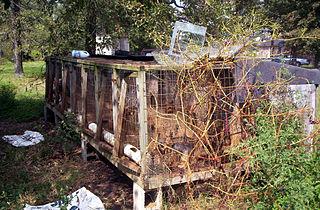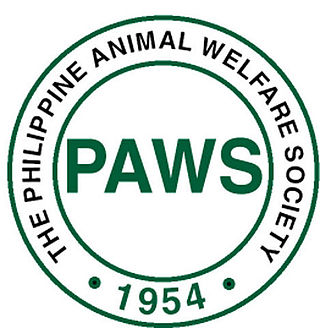
Pet adoption is the process of transferring responsibility for a pet that was previously owned by another party. Common sources for adoptable pets are animal shelters, rescue groups, or other pet owners. Some organizations give adopters ownership of the pet, while others use a guardianship model wherein the organization retains some control over the animal's future use or care.

An animal shelter or pound is a place where stray, lost, abandoned or surrendered animals – mostly dogs and cats – are housed. The word "pound" has its origins in the animal pounds of agricultural communities, where stray livestock would be penned or impounded until they were claimed by their owners.

A puppy mill, also known as a puppy farm, is a commercial dog breeding facility characterized by quick breeding and poor conditions. Although no standardized legal definition for "puppy mill" exists, a definition was established in Avenson v. Zegart in 1984 as "a dog breeding operation in which the health of the mill’s dogs is disregarded to maintain a low overhead and maximize profits". They are cited as being a result of increased demand for household pets, especially after World War II. The Veterinary Medical Association of the Humane Society of the United States defines the main characteristics of a puppy mill as "emphasis on quantity over quality, indiscriminate breeding, continuous confinement, lack of human contact and environmental enrichment, poor husbandry, and minimal to no veterinary care."

Greyhound adoption or Greyhound rescue programs focus on finding homes for Greyhounds who are no longer needed for racing. In some countries, they live in kennels at the track.
In some countries there is an overpopulation of pets such as cats, dogs, and exotic animals. In the United States, six to eight million animals are brought to shelters each year, of which an estimated three to four million are subsequently euthanized, including 2.7 million considered healthy and adoptable. Euthanasia numbers have declined since the 1970s, when U.S. shelters euthanized an estimated 12 to 20 million animals. Most humane societies, animal shelters and rescue groups urge animal caregivers to have their animals spayed or neutered to prevent the births of unwanted and accidental litters that could contribute to this dynamic.
A no-kill shelter is an animal shelter that does not kill healthy or treatable animals based on time limits or capacity, reserving euthanasia for terminally ill animals, animals suffering poor quality of life, or those considered dangerous to public safety. A no-kill shelter uses many strategies to promote shelter animals; to expanding its resources using volunteers, housing and medical protocols; and to work actively to lower the number of homeless animals entering the shelter system. Up to ten percent of animals could be killed in a no-kill shelter and still be considered a no-kill shelter.

The Philippine Animal Welfare Society (PAWS) is a volunteer-based, non-government organization whose goal is to prevent animal cruelty through education, animal sheltering and advocacy, based in Quezon City, Philippines. It was founded in 1954 by Muriel Jay. PAWS believes that the creation of a more peaceful society starts with the widening of mankind's circle of compassion which includes animals, thereby envisions a nation that respects animals, practices responsible pet ownership and protects wildlife. The volunteer-based organization rehabilitates these animals in the hope of finding them new homes and a second chance at a good life. PAWS does not take in pets of other people, but only victims of cruelty or neglect where the animal offenders are charged with violation of the Animal Welfare Act in court.

Compassion and Responsibility for Animals (CARA) is a registered non-profit, non-government animal welfare organization in the Philippines. It was founded in 2000 by a group of animal lovers determined to help the plight of animals in the Philippines. The current president of CARA is Nancy Cu-Unjieng.

Street dogs, known in scientific literature as free-ranging urban dogs, are unconfined dogs that live in cities. They live virtually everywhere cities exist and the local human population allows, especially in the developing world. Street dogs may be stray dogs, pets which have strayed from or are abandoned by their owners, or may be feral animals that have never been owned. Street dogs may be stray purebreds, true mixed-breed dogs, or unbred landraces such as the Indian pariah dog. Street dog overpopulation can cause problems for the societies in which they live, so campaigns to spay and neuter them are sometimes implemented. They tend to differ from rural free-ranging dogs in their skill sets, socialization, and ecological effects.
Abandoned pets are companion animals that are either inadvertently or deliberately abandoned by their owners, by either dumping the animals on the streets, leaving them alone in a vacant property, or relinquishing them at an animal shelter.
The National Animal Welfare Trust (NAWT) is an animal welfare charity founded in 1971, which operates rescue and rehoming centres for companion animals. It has branches in Watford, Berkshire, Essex, Bedfordshire and Cornwall. They operate a number of premises, including Trindledown Farm, the UK's only retirement home for elderly pets. Formerly known as the Animal Welfare Trust (AWT), it originated from the British Union for the Abolition of Vivisection.
The Lange Foundation is a 501(c)(3) non-profit organization founded in 1993 in West Los Angeles, California, by Gillian Lange. The organization is a no-kill shelter committed to rescuing stray and abandoned animals and facilitating adoptions. Animals that are not adopted may remain at the kennel indefinitely without consequence.

The Animal Rescue Foundation (ARF) is a nonprofit organization founded by Elaine and Tony La Russa, based in Walnut Creek, California. ARF rescues dogs and cats from public animal shelters where they would otherwise be euthanized and adopts them into new homes. Their programs include a spay and neuter clinic, training classes, psychiatric service dog training for military veterans, a volunteer therapy dog program, and humane education programs for children.
Humane Animal Rescue of Pittsburgh (HARP), formerly known as the Animal Rescue League of Western Pennsylvania, known commonly as Animal Rescue League Shelter & Wildlife Center (ARL), is an animal welfare organization founded in Pittsburgh, Pennsylvania, in 1909. The ARL is a non-profit organization that offers various services to support both animals and pet owners alike. It is the only animal shelter in the Pittsburgh area that accepts both domestic animals and wildlife. The agency's shelter and clinic are located in Pittsburgh's East Liberty neighborhood, while its wildlife rehabilitation center and boarding kennels are a few miles away in Verona, Pennsylvania. The organization maintains a contract with the city of Pittsburgh and accepts all stray pets that are apprehended by the Animal Control unit.
Safe Humane Chicago is a nonprofit animal advocacy organization founded in 2008 by animal rights advocate Cynthia Bathurst. The nonprofit works to educate youth on animal safety and seeks justice for dogs that have been confiscated by law enforcement by placing them in foster care to later be adopted into new homes.
Manchester and Cheshire Dogs’ Home is a registered animal charity which operates two dog shelters in North West England. The charity takes in and cares for stray and unwanted dogs, making the animals available for adoption once they are fit and healthy. The charity also promotes responsible dog ownership by the public. Manchester Dogs’ Home has cared for and rehomed more than one million dogs since it opened.
The Humane Society of Harford County, Inc. (HSHC) is a nonprofit open admission animal shelter located in Fallston, Maryland, contracted with the Harford County Government to provide sheltering services for all animals brought to HSHC by Animal Control as stray, or subjects of animal cruelty or neglect cases.
Internet Miniature Pinscher Service (IMPS) is a non-profit animal rescue organization based in United States of America. The organization was established in 1998 by Petie Hoving Durand and is dedicated to adoption and rescue of Miniature Pinscher, a small breed of dogs originating from Germany. Internet Miniature Pinscher Service (IMPS) is the largest single breed rescue service in America. Currently, organization operates in United States of America and Canada. The organization has to date rescued over 20,000 dogs and currently has 500 volunteers throughout the United States and Canada.
The Sato Project is an animal rescue and protection organization founded in 2011 by British-born Christina Beckles. It works to rescue abused and abandoned dogs in Puerto Rico, educating the public and advocating for abused and abandoned dogs. "Sato" is the Spanish word used in Puerto Rico and Cuba for referring to stray dogs or cats. Many of the project's missions have involved airlifting dogs before and after natural disasters, including Hurricane Maria in 2017 and the earthquakes that struck Puerto Rico in 2019 and 2020. "Spayathon" is a spaying and neutering program, attended by Sato Project and other animal rights organizations in Puerto Rico, which has had an impact on the stray dog population.

Animal Kingdom Foundation or simply AKF, is a non-profit animal welfare non-governmental organization based in the Philippines. Founded in 2002, it is committed to "improving the living and welfare conditions of animals", eliminating the trade of dog meat for human consumption, and advocating for the improvement of animal living conditions.








